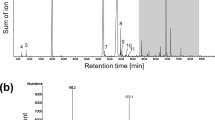Abstract
The stereoisomeric composition of the copulation release pheromone of the azuki bean weevil, Callosobruchus chinensis L., was determined to be R:S = 3.3–3.4:1 by the 2D-Ohrui–Akasaka method.



Similar content being viewed by others
References
Abo, M. and Mori, K. 1993. Synthesis of (R)-callosobruchusic acid from methyl (R)-3-carboxybutanoate. Biosci. Biotechnol. Biochem. 57:265–267.
Akasaka, K. and Ohrui, H. 1999. Enantiomeric separation of branched fatty acids after conversion with trans-2-(2,3-anthracenedicarboximido)cyclohexanol, a highly sensitive chiral fluorescent conversion reagent. Biosci. Biotechnol. Biochem. 63:1209–1215.
Akasaka, K. and Ohrui, H. 2004. Chiral discrimination of branched-chain fatty acids by reverse-phase HPLC after labeling with a chiral fluorescent conversion reagent. Biosci. Biotechnol. Biochem. 68:153–158.
Akasaka, K., Meguro, H., and Ohrui, H. 1997. Enantiomeric separation of carboxylic acids having chiral centers remote from the carboxyl group by labeling with a chiral fluorescent derivatization reagent. Tetrahedron Lett. 38:6853–6856.
Akasaka, K., Imaizumi, K., and Ohrui, H. 1998. Enantiomeric separation of branched fatty acids having chiral centers remote from the carboxyl group by labeling with chiral fluorescent derivatization reagents. Enantiomer 3:169-174.
Akasaka, K., Shichijyukari, S., Matsuoka, S., Murata, M., Meguro, H., and Ohrui, H. 2000. Absolute configuration of a ceramide with a novel branched-chain fatty acid isolated from the epiphytic dinoflagellate, Coolia monotis. Biosci. Biotechnol. Biochem. 64:1842–1846.
Akasaka, K., Shichijyukari, S., Meguro, H., and Ohrui, H. 2002. Determination of the absolute configuration of the anteiso acid moieties of glycoglycerolipid S365A isolated from Corynebacterium aquaticum. Biosci. Biotechnol. Biochem. 66:1719–1722.
Erni, F. and Frei, R. W. 1978. Two-dimensional column liquid chromatographic technique for resolution of complex mixtures. J. Chromatogr. 149:561–569.
Fontana, E. A., Carpita, A., and Rossi, E. 1993. A simple synthesis of (R)(S)(E)-3,7-dimethyl-2-octene-1,8-dioic acid, a copulation release pheromone component of the Azuki bean weevil. Synth. Commun. 23:2797–2805.
Giersch, W. and Schulte-elte, K. H. 1990. Enantiomeric 3,7-dimethylocta-1,7-dienes as useful chiral building blocks. A new access to both optical antipodes of natural (E)-3,7-dimethyloct-2-ene-1,8-diol and (E)-3,7-dimethyloct-2-ene-1,8-dicarboxylic acid. Helv. Chim. Acta. 73:733–738.
Gramatica, P., Giardina, G., Speranza, G., and Manitto, P. 1985. Bakers' yeast hydrogenation of carbonyl activated double bonds. Enantioselective synthesis of the (S)-form of the dihydroterpenediol secreted by Danaus chrysippus and of a pheromone of Callosobruchus chinensis L. Chem. Lett. 1395–1398.
Imaizumi, K., Terashita, H., Akasaka, K., and Ohrui, H. 2003. Highly potent chiral labeling reagents for the discrimination of chiral alcohols. Anal. Sci. 19:1243–1249.
Kang, S. K. and Lee, D. H. 1987. A short synthesis of (±)-callosobruchusic acid, the copulation release pheromone (erectin) of the azuki bean weevil. Bull. Korean Chem. Soc. 8:487–488.
Matsuhashi, H. and Shimada, K. 2002. Chemical transformation of leustroducsins: synthesis of leustroducsin B. Tetrahedron 58:5619–5626.
Mori, K. 1998. Separation of enantiomers and determination of absolute configuration, pp. 313–326, in J. G. Millar and K. F. Haynes (eds.). Methods in Chemical Ecology, Vol 1. Chemical Methods. Kluwer Academic Publishers, Norwell, Massachusetts.
Mori, K., Ito, T., Tanaka, K., Honda, H., and Yamamoto, I. 1983. Synthesis and biological activity of optically active forms of (E)-3,7-dimethyl-2-octene-1,8-dioic acid (callosobruchusic acid). A component of the copulation release pheromone (erectin) of the azuki bean weevil. Tetrahedron 39:2303–2306.
Morohashi, A., Satake, M., Nagai, H., Oshima, Y., and Yasumoto, T. 2000. The absolute configuration of gambieric acids A–D, potent antifungal polyethers, isolated from the marine dinoflagellate Gambierdiscus toxicus. Tetrahedron 56:8995–9001.
Nakai, T., Yajima, A., Akasaka, K., Kaihoku, T., Ohtaki, M., Nukada, T., Ohrui, H., and Yabuta, G. 2005. Synthesis of the four stereoisomers of 2,6-dimethyloctane-1,8-dioic acid, a component of the copulation release pheromone of the cowpea weevil, Callosobruchus maculatus. Biosci. Biotechnol. Biochem. 69:2401–2408.
Nanda, S. and Scott, A. I. 2004. Asymmetric synthesis of (E)- and (Z)-3,7-dimethyl-2-octene-1,8-diol and callosobruchusic acid. Tetrahedron: Asymmetry 15:963–970.
Nojima, S., Shimomura, K., Honda, H., Yamamoto, I., and Ohsawa, K. 2007. Contact sex pheromone components of the cowpea weevil, Callosobruchus maculatus. J. Chem. Ecol. DOI 10.1007/s10886-007-9266-5.
Ohshiro, T., Namatame, I., Nagai, K., Sekiguchi, T., Doi, T., Takahashi, T., Akasaka, K., Rudel, L. L., Tomoda, H., and Ohmura, S. 2006. Absolute stereochemistry of fungal beauveriolide III and ACAT inhibitory activity of four stereoisomers. J. Org. Chem. 71:7643–7649.
Tanaka, K., Ohsawa, K., Honda, H., and Yamamoto, I. 1981. Copulation release pheromone, erectin, from the azuki bean weevil (Callosobruchus chinensis L.). Journal of Pesticide Science 6:75–82.
Tanaka, K., Ohsawa, K., Honda, H., and Yamamoto, I. 1982. Synthesis of erectin, a copulation release pheromone of the azuki bean weevil, Callosobruchus chinensis L. Journal of Pesticide Science 7:535–537.
Tashiro, T., Akasaka, K., Ohrui, H., Fattorusso, E., and Mori, K. 2002. Determination of the absolute configuration at the two cyclopropane moieties of plakoside A, an immunosuppressive marine galactosphingolipid. Eur. J. Org. Chem. 3659–3665.
Wenkert, E. and Khatuya, H. 1999. Formal synthesis of (±)-callosobruchusic acid. Synth. Commun. 29:3051–3055.
Yajima, A., Akasaka, K., Nakai, T., Maehara, H., Nukada, T., Ohrui, H., and Yabuta, G. 2006. Direct determination of the stereoisomer constitution by 2D-HPLC and stereochemistry–pheromone activity relationship of the copulation release pheromone of the cowpea weevil, Callosobruchus maculatus. Tetrahedron 62:4590–4596.
Yu, G.-A., Huang, J.-X., Hou, J.-L., Li, Y., and Xu, Z.-H. 2002. Synthesis of (R,E)-3,7-dimethyl-2-octene-1,8-dioic acid, a copulation released pheromone component of Azuki bean weevil. Chem. Res. Chin. Univ. 18:397–399.
Acknowledgments
We wish to acknowledge the technical help provided by Professor K. Ohsawa, Professor S. Yajima, and Mr. K. Shimomura (Tokyo University of Agriculture) in the isolation of the pheromone.
Author information
Authors and Affiliations
Corresponding author
Rights and permissions
About this article
Cite this article
Yajima, A., Akasaka, K., Yamamoto, M. et al. Direct Determination of the Stereoisomeric Composition of Callosobruchusic Acid, the Copulation Release Pheromone of the Azuki Bean Weevil, Callosobruchus chinensis L., by the 2D-Ohrui-Akasaka Method. J Chem Ecol 33, 1328–1335 (2007). https://doi.org/10.1007/s10886-007-9311-4
Received:
Revised:
Accepted:
Published:
Issue Date:
DOI: https://doi.org/10.1007/s10886-007-9311-4




